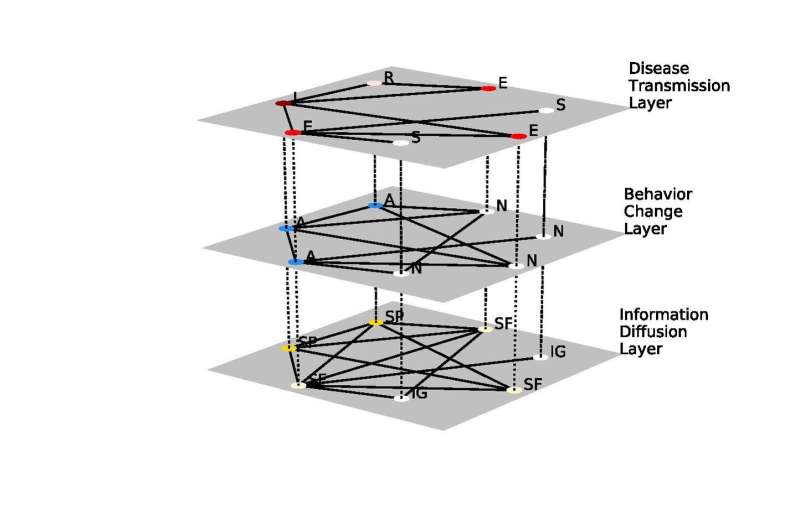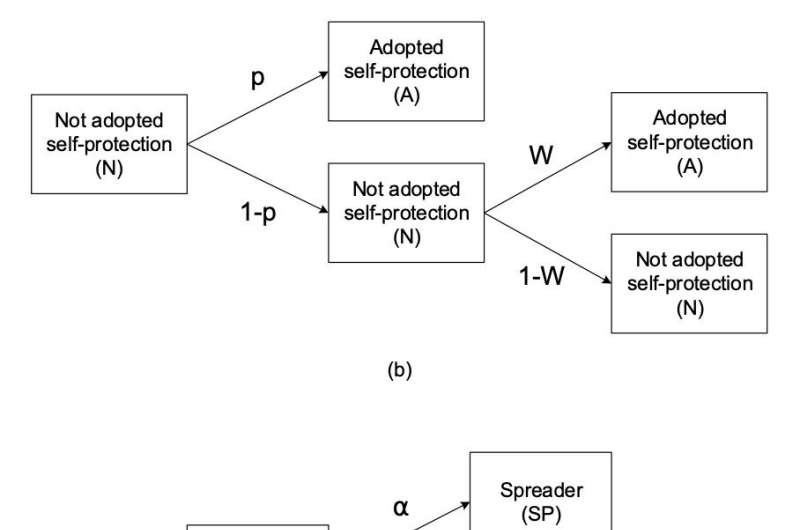
A research team led by City University of Hong Kong (CityU) has built a mathematical model to explore and analyze the relationship between disease transmission, people's awareness about the disease and their resulting behaviors, as well as information spread by the mass media and opinion leaders. The research may shed some insights on responding to COVID-19 and other similar infectious diseases.
The research team is led by Dr. Zhang Qingpeng, associate professor of the School of Data Science (SDSC) at CityU. Their findings have been published in the scientific journal Physical Review E, titled "Effect of heterogeneous risk perception on information diffusion, behavior change, and disease transmission."
Factors motivating the public to fight against the diseases
Individuals taking adequate measures to fight against disease can stop it from spreading. But before the public can develop self-protection awareness, they have to know about the disease with correct understanding. However, on the basis of knowing the occurrence of an epidemic, people's subjective perceptions of the severity of the epidemic are affected by factors including past experience, information spread by the media and opinion leaders, therefore resulting in different preventive behaviors.
Dr. Zhang said, "For example, in Hong Kong, people were deeply concerned about COVID-19 in the early stage of its outbreak as, they had experienced SARS (severe acute respiratory syndrome) in 2003. Many citizens started wearing masks consciously to protect themselves even before a single case was confirmed in Hong Kong." He believed that because many citizens have developed self-protection awareness and taken actions like wearing masks and using alcohol-based handrubs, Hong Kong successfully contained the first wave of COVID-19 during the 2020 Chinese New Year.
"On the contrary, people in Europe and the United States did not take it seriously in the early outbreak of COVID-19. They did not wear masks, and even the government did not stock up sufficient resources for fighting the disease," said Dr. Zhang. He pointed out that even later, when the situation has worsened in the United States, many people still did not implement protective measures and often even opposed the epidemic control measures.

One key factor: perception and judgment of the epidemic's severity
Some previous studies have used mathematical models to investigate how people's awareness of disease affects outbreaks. However, few studies considered the heterogeneity of public responses towards media coverage and opinion leaders' views. Referencing other studies, Dr. Zhang pointed out that the public's willingness to take self-protection actions (for example, wearing masks and keeping social distance) and to share disease-related information with the others would be influenced not only by media coverages, but also by personal risk perception, their subjective judgment about the severity of the disease.
The research team observed that in the ongoing COVID-19 pandemic, there are differences in risk perceptions between people, which resulted in different behaviors in response to the outbreak. That observation drove the research. Dr. Zhang's team proposed a mathematical model to analyze disease transmission, behavior change and information diffusion. This is the first study that considered both subjective risk perception and the public's awareness of diseases.
Dr. Zhang explained the relationship between disease, behavior and information. "Mass media and opinion leaders would spread the information about the disease, including the transmissibility and severity. People who have access to this information would be aware of the disease, and then they would judge their own risk of being infected. Some people would take action to protect themselves, for example, purchasing protective gear like masks. This would subsequently affect disease transmission by changing the actual infection rate."
Scientific and fair media coverage help in building awareness of fighting the epidemic
Their calculation results showed that if enough number of citizens are informed of the transmissibility and severity of the disease and willing to adopt personal protection actions, the outbreak could be effectively contained. Dr. Zhang pointed out that people who were unaware of disease information did not protect themselves, as they did not know the risk. Individuals who have access to disease information with a higher subjective risk perception are found to be more actively engaging in self-protection and information sharing.
Dr. Zhang believes that opinion leaders' views and media coverage on the epidemic could raise the public's awareness and influence them in consideration of taking self-protection measures. Therefore, both the opinion leaders and media played important roles in the prevention and control of the epidemic. However, Dr. Zhang elaborated that they should be careful while disseminating epidemic information. "Deliberately downplaying the severity of the epidemic may cause the public to let their guard down and lead to more infections. On the other hand, over-exaggeration of the severity of the epidemic may make the public distrust the public health system," he added.
Moreover, their mathematical model calculations showed that social influence is also an important factor. People's behaviors are affected by their friends' behaviors. In social networks, if opinion leaders have taken appropriate anti-epidemic behaviors, the wider public would also be motivated to take anti-epidemic actions, which could significantly reduce the scale of disease outbreaks.
Explore further
Provided by City University of Hong Kong
Citation: Mathematical model verifies a correct understanding of epidemic's severity (2021, January 27) retrieved 27 January 2021 from https://ift.tt/3aaDM8r
This document is subject to copyright. Apart from any fair dealing for the purpose of private study or research, no part may be reproduced without the written permission. The content is provided for information purposes only.
"correct" - Google News
January 27, 2021 at 07:53PM
https://ift.tt/3aaDM8r
Mathematical model verifies a correct understanding of epidemic's severity - Phys.org
"correct" - Google News
https://ift.tt/3d10rUK
https://ift.tt/35qAk7d
Bagikan Berita Ini














0 Response to "Mathematical model verifies a correct understanding of epidemic's severity - Phys.org"
Post a Comment